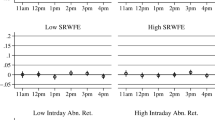Abstract
This paper examines the effects of partial information on volatility and on the design of simple feedback rules in a rational expectations context. Previous studies have investigated these effects using small analytical models. Here we employ an empirical two-bloc model derived from the OECD Interlink model. The main conclusions are that when current asset prices are observed, but GDP is observed with a delay, then the effect on volatility is small, compared to the full information case. Likewise the choice of simple feedback rules is little affected, although a non-optimal use of information in their design may lead to a deterioration in performance.
Similar content being viewed by others
References
Blanchard, O.J. and Khan, C.M. (1980), The solution of linear difference models under rational expectations, Econometrica 48.
Currie, D.A., Levine, P.L., and Vidalis, N. (1987), ‘Cooperative and non-cooperative rules for monetary and fiscal policy in an empirical two-bloc model’, in R.L. Bryant and P. Portes, eds. Global Macroeconomics: Policy Conflict and Cooperation, Macmillan.
CurrieD.A. and LevineP.L. (1984), ‘Exchange rate and price level volatility under partial information’, Greek Economic Review 16, 149–170.
LevineP.L. and CurrieD.A. (1987), ‘The design of feedback rules in linear stochastic rational expectations models’, Journal of Economic Dynamic and Control 11, 1–28.
Levine, P.L., Currie, D.A. and Gaines, J. (1989), ‘The use of simple rules for international policy agreements’, in M. Miller, B. Eichengreen and R. Portes eds. Blueprints for Exchange Rate Management, Academic Press, Ltd.
Masson, P., Blundell-Wignall, A., and Richardson, P. (1984) ‘Domestic and international effects of government spending under rational expectations’, OECD Economic Studies, Autumn, pp. 177–190.
Masson, P. and Richardson, P. (1983), ‘Exchange rate expectations and current balances OECD interlink system’, in Proceedings of the Fourth International Workshop of the Applied Econometric Assoc., Brussels, December.
PearlmanJ.G., CurrieD.A., and LevineP.L. (1986), ‘Rational expectations models with partial information’, Economic Modelling, 3, 90–105.
TaylorJ. (1985), ‘International co-ordination in the design of macroeconomic policy rules”, European Economic Review 28, 53–81.
WilliamsonJ. and MillerM.H. (1987), ‘Targets and indicators: A blueprint for the international co-ordination of economic policy’, Policy Analysis in International Economics 22, Institute for International Economics, Washington.
Author information
Authors and Affiliations
Rights and permissions
About this article
Cite this article
Currie, D., Levine, P. & Pearlman, J. Partial information and volatility in a two-bloc world. Economics of Planning 24, 13–26 (1991). https://doi.org/10.1007/BF00361112
Issue Date:
DOI: https://doi.org/10.1007/BF00361112




